Recent Articles
-
Christmas Sword Buying Guide 2025
Dec 03, 25 10:53 PM
Pilsen Rapier Double Review
DISCONTINUED
This sword has been discontinued and is no longer in production or available, but is preserved on the site for informational purposes.
The Pilsen Rapier by Windlas Steelcrafts is one of the few affordable entry level Rapiers on the market. However, in this double review (by two people) they both come to the same conclusion.
It has one major problem - and both reviewers found it in pretty short order..
What is the issue, and is this sword still redeemable? Read on and see for yourself..
Pilsen Rapier Double Review
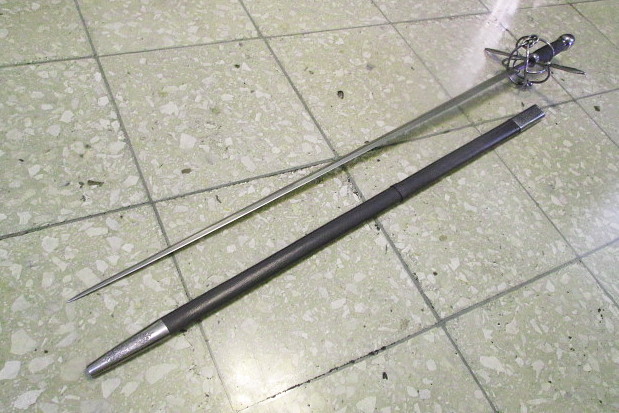
Review # 1 by SBG Member Beowulf
The Pilsen Rapier is a currently available rapier from
Windlass Steelcrafts that often comes up when someone asks about
purchasing a cheap or good looking, or unusual rapier. Though this piece
is often mentioned in passing only one SBG member that we known about has handled or owned this weapon - Dave Kelly.
A few of Mr. Kelly's comments about the one he owned
were rather neutral or slightly south-of-neutral, such as that his had a
marginally acceptably stiff blade, and that he felt it was more of a
foil than a rapier due to length and balance.
My knowledge
stops at about 1500 A.D. I am a medieval weapon/period buff and a HEMA
(Kunst des Fechten) practitioner studying European Martial Arts from
roughly the 12th century through to about 1500, with the caveat that
many weapons surviving past this self imposed limit I could handily use
because they have direct medieval (and HEMA) analogues.
Rapiers however
are totally alien to me.
I purchased this to try and fill a gap. I
own a Windlass Steelcrafts Musketeer set (rapier and parrying dagger)
and a Hanwei Sidesword. My Hanwei sidesword is fast, light, a helluva
lot of fun but frustrating to me because it *is* so light. My Musketeer
rapier I can only use for fifteen minutes or so before the weight of it
starts to badly fatigue my wrist.
I was hoping for two qualities with
this Pilsen: light enough to use for long periods so I can learn rapier
basics, and a rapier I can use for a bit more than just thrusting. While
I really like my Musketeer I find it still VERY ponderous in the cut.
The Pilsen was for hopefully bridging this gap between the sidesword and
the Musketeer, something to give me a way to "work up to" the
Musketeer.
Another intriguing thing about the Pilsen is it's
stats. If you were to look up the stats and then say, find stats on
quality high end rapier reproductions you might be surprised. I noticed
this and it was the deal cincher for me with my Pilsen purchase. This
piece somewhat follows the stats of a few select high end reproductions
in areas such as weight, point of balance, length, distal taper etc.
Understand though, stats are only one aspect of a sword. Something that
looks good on paper might feel heavy and dead in the hand. Swords (and
their handlers) are dynamic things. It still stands though, the stat
comparison was intriguing enough to make me plop down my funds and take
my chances. Besides, I wanted to see a distally tapered Windlass sword
first hand.
What I got..
My first impressions. Pretty. A smaller hilt than I had imagined. Longer than I had thought, it is almost the length of my Musketeer. The scabbard could have been nicer, it is marred by very DARK glue squeezed out the ends of the metal throat and chape onto the lizard-skin textured leather.
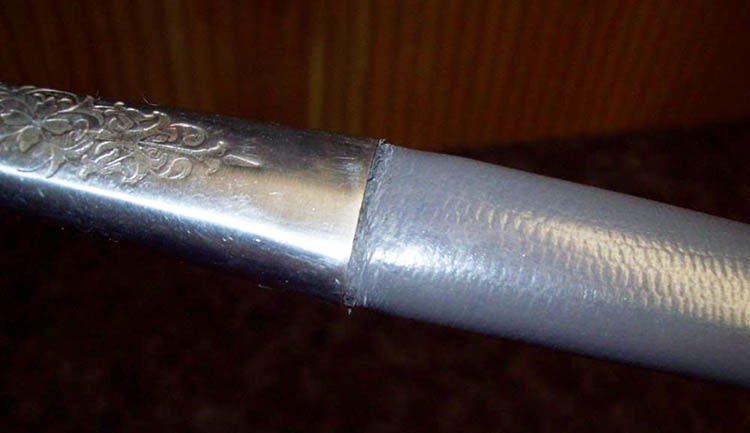 Chape messiness.
Chape messiness.The scabbard's leather DOES match the handle leather, I have read many comments from owner's stating that there is a mismatch between these. I was lucky apparently. My scabbard is actually TWO pieces of leather, joined (stitched) right in the middle of the scabbard's body and the seam covered with a small matching leather strip- which is sown by the back-stitching into the whole piece.
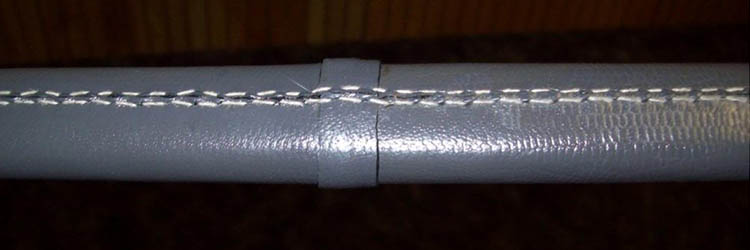 Scabbard join.
Scabbard join.Very acceptable little thing for me. Unlike my Musketeer scabbard this scabbard is stiff enough that at first I thought it was a wood cored piece. I have a theory that the texturing (stamping) of the leather coupled with the two piece construction has made it especially stiff.
Bars/loops/rings of the guard are of a good larger diameter to be protective. Bars/loops/rings are mostly symmetrical. Cross is well executed with the classic Reitschwert shaping to them. Handle stitching is typical, large but tight, reminiscent of a dog food bag "zip" stitching.
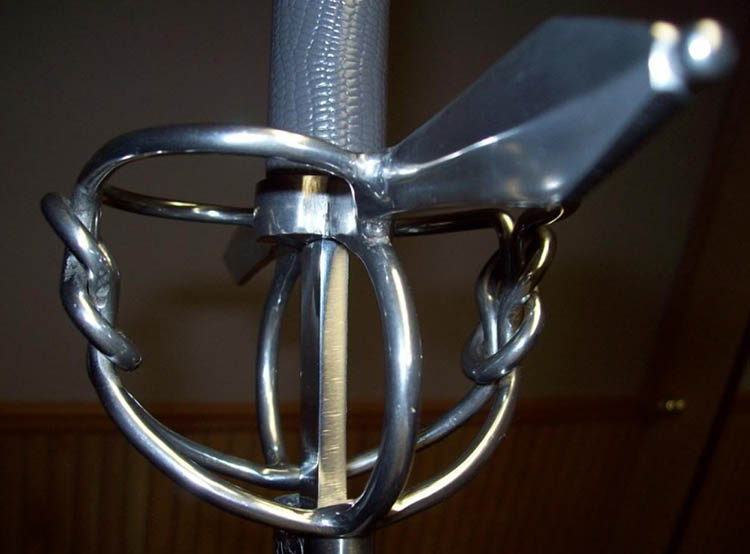 Quillon block, overbuilt for justice!
Quillon block, overbuilt for justice!The handle is
round. It does not bother me because this is a rapier- I have a lock
onto the tang with my "rapier grip", therefore edge alignment (a bit of a
silly thing for this weapon) is still there and available to me. Blade
IS distally tapered! It is gentle, it is understated but it is there,
feelable by running my pinched fingers down the spine from base to tip.
Blade
is an "estoc" or "stiletto" shape: narrow with a tall/robust diamond
cross-section. It would be improved by the addition of a short and deep
fuller running from the base to one third down the blade like most
original "estoc" style rapier blades have. My blade is quite stiff,
again I have been lucky. Pay attention here: in my opinion there is
every reason to believe because of the blade shape and mass production
that many of these WILL be too whippy/flexible. This seems inevitable to
me.
Now for the interesting bits. After cleaning it up
(deliberately NOT seating my hand properly into the hilt for a heft) I
put on some good fencing gauntlets and tried it out. My hand almost
does not clear the little Hercules Knot "basket"! This assembly is a
quite small diameter thing. The bars press tightly into the back of my
hand. If you're an average sized (or smaller) person I think you'll have
no problems whatsoever. My wife can use it as it is meant to be used. I
am (unfortunately in this one instance) the size of a tree.
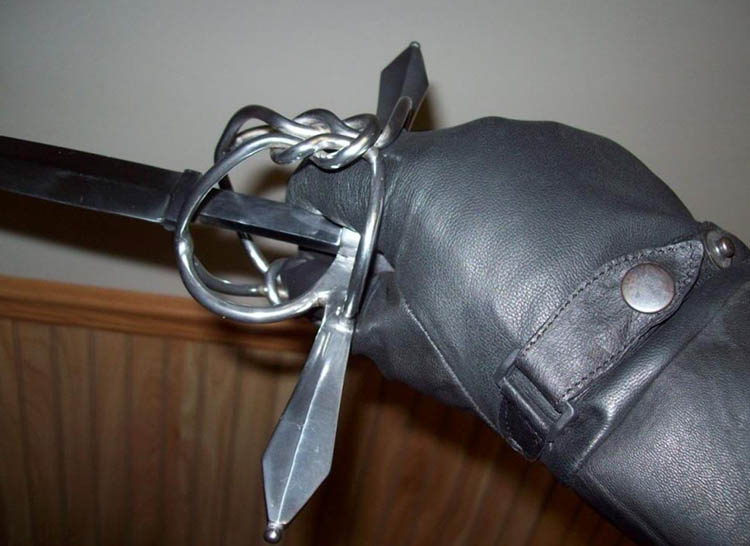 Patented "ouch!" grip method.
Patented "ouch!" grip method.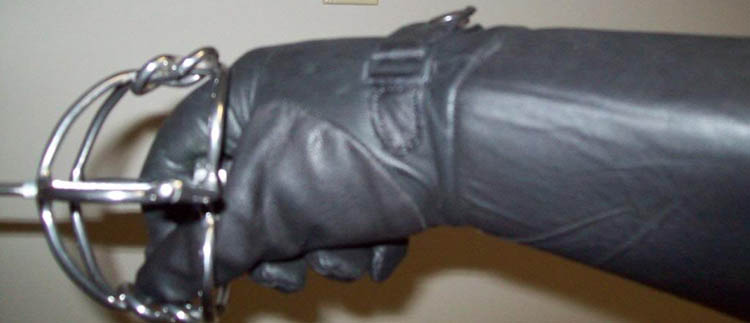 Another view of the "ouch!" method.
Another view of the "ouch!" method.I took it outside on the
last spring-like day of this year and put it through its paces. Light,
responsive, capable of quick sideways cutting motions, capable of
complex blade movements. I really enjoyed being able to use this for a
half hour without hand and wrist muscle fatigue. For me this does fill
my two objectives and this will bridge the gap between sidesword and
rapier. Which is odd, because this is also a basic description of this
weapon: not a sidesword and not a full-on deadly length and massive
rapier.
Bringing it inside it was time to look under the hood. I
was surprised, the pommel immediately spun on it's threads. Within a
minute I had this rapier apart. Things of interest: the exposed piece of
blade tang DOES NOT extend down through the guard at IT'S FULL SIZE.
What you see with the weapon assembled is the *end* of these dimensions.
The tang immediately narrows again and THAT is what is running through
the guard. To me (a medieval sword guy) the tang is frightening. I got
online and found several pictures of antique rapier tangs, this tang is
sufficient. What is questionable is what I just outlined about the
guard/tang juncture. The tang only goes into the pommel a half inch.
There is sufficient handle length to trim it down for a longer more
robust pommel fit. There is also the guard/tang juncture- one could file
the guard slot larger and wedge the guard onto the robust tang section,
yet again freeing up more tang length to sink into the pommel.

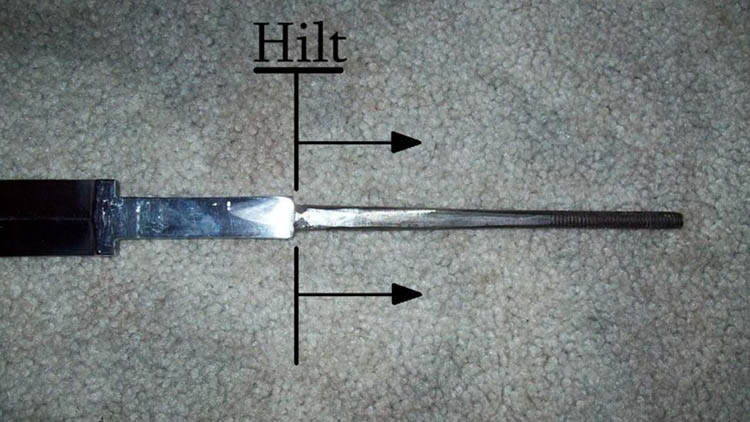
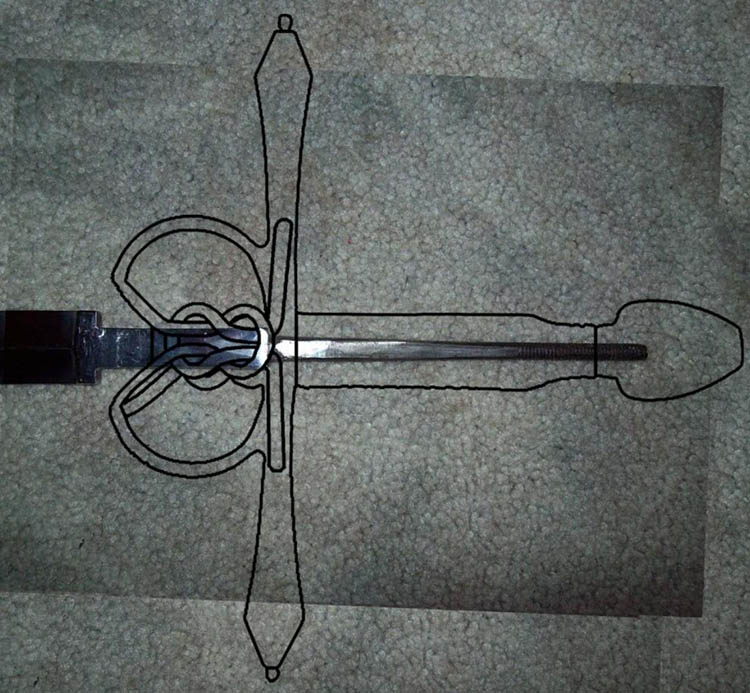
As far as my hand fitting into the "basket": The quillon block of this
guard is VERY blocky. Of the hundreds of pictures of antique rapiers I
have looked over in online auctioneer and museum sites I have not seen
something quite like this. Mostly the quillon block area of rapiers is
quite thin, hugging closely to the blade/tang or if robust (as on the
German "Town Guard" pattern swords) it is gently rounded and curved.
This is logical as the user hooks their index finger over the tang/blade
right here, and sometimes even pinches the tang/blade between thumb and
side of index finger. For me to be able to help my hand clear the
"basket" I will have to reshape the quillon block, narrowing it
significantly and rounding it off. I can't change the "basket", but I
can change the one thing that looks off to me on the piece. Logic for
the win.
At first I had thought about sending this piece back
because it has such tight confines available for my hand in use. But I
immediately felt wrong about that and a bit sad. I genuinely think this
is a beautiful, or perhaps strangely beautiful weapon. That I feel is
honest sentiment. Though I can really see how to someone with a better
eye and knowledge this piece might be just "too wrong" I am enjoying it.
I like the "prestige weapon" feel and look. I like how this thing also
seems like something that came from some semi-historical piece of
fantasy media. My wife immediately understood when I dubbed this the
"Sheogorath Rapier" (Elder Scrolls Oblivion Video Game).
This is
not a good example of a rapier. This is definitely not a side sword.
This is something which existed within that world between those two
iconic weapon types.
This could be a rapier which fights much as
a side sword, alternately one could make the case that this is a rapier
turning into a smallsword, with the flair and styling of a reitschwert.
We modern people have an obssession with classification. In the end I
am happy I picked it up and looking forward to making it better. Thanks for the read!
Review # 2: by SBG member pgandy
I thought that I would share my experience with my new toy a Windlass Pilsen Rapier. The reader should read Beowulf’s review on this rapier first.
Up to this point the only ones I’ve seen have been in museums, much
less have I ever held one or have been schooled in their use. That
should be taken in consideration regarding my opinions.
All of my experience has been with cut/thrust and chopping swords, and I have no western swords. When the “new sword bug” bit me I decided to expand my knowledge, get a thrusting sword and opted for a rapier as I’ve always admired their lines. I went to KoA as I’ve dealt with them before due to their low prices and large inventory, later checked other sites, and returned to KoA.
I choose the Pilsen not so much because of any virtue it possessed as much as elimination and compromise. It looked like an introductory level rapier was going to sell for $200 at KoA. I was surprised that the shipping and other expenses added only another $145.50. I was expecting another $100 that was not included. I do not live in the US and it is expensive to import to my country. I received the rapier in a record breaking time of just under two weeks and that included KoA’s estimated 7-12 days for sharpening. I was not expecting it for another 1-1½ months. It appears that the law has changed, I hope I hope.
I must have gotten the last one as they are now on back order. Other than a 36 1/8” blade, I liked what I got more than those specs. Mine weighed in at 2.45 lb, more to my liking. The blade thickness is 7.0mm-3.8mm (1½” from tip), again more to my liking as a stiff blade was at the top of my requirement list. I had considered the advertised 6.4mm the minimum that I was looking for. I understand there is much variation in Windlass’ rapiers.
First Impressions
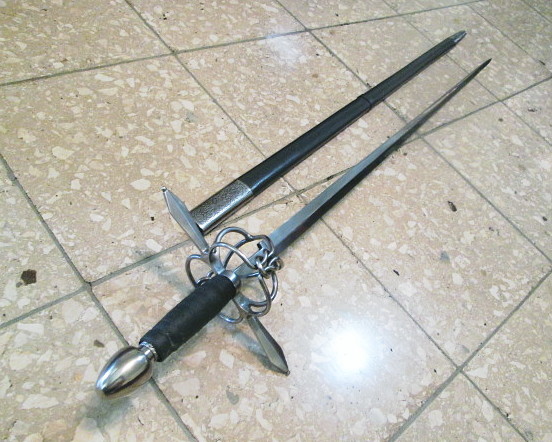
My first impression on seeing it at the pickup station was that the metal lacked the lustre shown in the ad, not a big deal by any means. Upon returning home I had to immediately examine my new prize. UHG!! What a disappointment!
Beowulf had stated in his review that the quillion block was small for his hand. He also stated that his hands were large, his wife had no problem, and that he thought that an average size man would have no problem. He failed to put numbers around his statements. He also failed to respond to my PM. I weigh 165 lbs. and have a size 8 (M) hand and had difficulty grasping the sword. My hand just wouldn’t fit and found it most painful. In addition I was disappointed with KoA’s sharpening as it seemed like anything but professional. The grind marks were clearly visible and the outer edges of the blade wavered. Having said that, I must confess that I would opt for KoA to sharpen again as this gave me a good starting point and saved time when I finished the job. And in answer to a thread that I saw some time back, KoA does sharpen in house. The big surprise came when I slid the sword across my lap to reposition for further viewing. I snagged my bed cover, damaging it. Somebody had dropped the rapier allowing it to land point first bending about 3/64”, maybe more, of the tip to a right angle to the rest of the blade. It was beyond the help of a stone and reshaped with a file. This was clearly a KoA or a fumbling customs’ inspector issue and not a Windlass. The diameter of the grip of 1” with its parallel sides did not fit my hand in the least. It was too small for me and the rapier constantly slipped ever so slightly in my grasp, a very annoying feature. I could disguise this by wearing gloves, but this only made me realize the small guard more. And I don’t want to dawn a glove every time I handle the rapier.
I was completely disgusted, and the thought of returning the sucker popped into my head. Then I thought about the expense to send it back. I already had an additional $145 tied up in to get it here and to send it back would have added to that, not to mention the cost to bring another one here, so a return was cost prohibitive. Then I remember that I had the blade sharpened so that in itself probably would void any return.
What to do was the question of the day. I played with it for a couple of nights trying different hand positions. The biggest result was creating a bruise on the right index finger knuckle. The sucker was absolutely useless to me. Not only did I get a bruise but there were several pressure points that irritated my finger to the point a grip was not possible for more than a short length of time. The rapier was well made but must have been designed by a sadist(s).
After a couple of nights studying the problems I decided to go to work on it as I had nothing to lose. I couldn’t return it nor could I use it. The quillion block is composed of round heavy gauge wire as seen in the photo. What is not evident is where there is a join Windlass squared off the welded joints. Those 90° corners, especially two, played hell with my index finger. I rounded those off. There was another 90° corner on the piece of metal in the quillion block directly in front of the wood grip and between the quillion arms that was bothersome. I brought that shoulder back giving it a generous radius. This not only took the pressure off the finger at that point but allowed my hand to move forward and taking the pressure off the back of the hand. I then added to the clearance by grinding metal from the inside of the rings. This in addition to giving a little more room, flattened that surface distributing the pressure over a larger area. I can now comfortably grasp the rapier, but more room would be preferable. As for the miserable 1” grip, I increased that to 1¼” by wrapping with friction tape and giving a slight bulge in the middle to better fill my hand. This wrap is a temporary fix using a material that I had on hand. I have ordered rescue tape to finish the job. Rescue tape is unknown to me and if I find it unsatisfactory will order in some tennis racket tape. The friction tape after applying talc powder to the outer surface is working fine but I hope the other tape will be more pleasing to the eye.
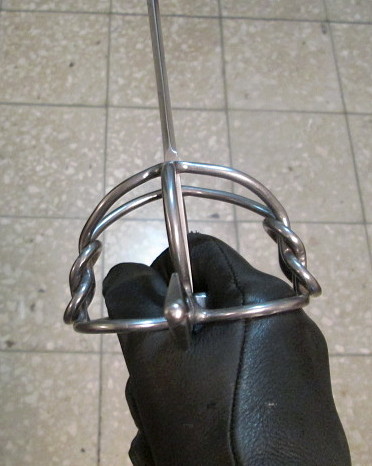
I was completely disgusted, and the thought of returning the sucker popped into my head. Then I thought about the expense to send it back. I already had an additional $145 tied up in to get it here and to send it back would have added to that, not to mention the cost to bring another one here, so a return was cost prohibitive. Then I remember that I had the blade sharpened so that in itself probably would void any return.
What to do was the question of the day. I played with it for a couple of nights trying different hand positions. The biggest result was creating a bruise on the right index finger knuckle. The sucker was absolutely useless to me. Not only did I get a bruise but there were several pressure points that irritated my finger to the point a grip was not possible for more than a short length of time. The rapier was well made but must have been designed by a sadist(s).
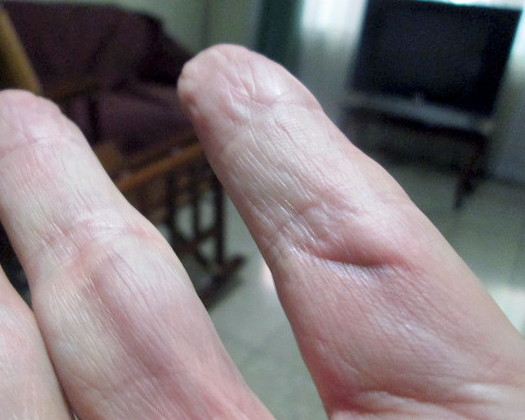 This shows the effects of one of the pressure points.
This shows the effects of one of the pressure points.After
a couple of nights studying the problems I decided to go to work on it
as I had nothing to lose. I couldn’t return it nor could I use it. The
quillion block is composed of round heavy gauge wire as seen in the
photo. What is not evident is where there is a join Windlass squared
off the welded joints. Those 90° corners, especially two, played hell
with my index finger. I rounded those off. There was another 90°
corner on the piece of metal in the quillion block directly in front of
the wood grip and between the quillion arms that was bothersome. I
brought that shoulder back giving it a generous radius. This not only
took the pressure off the finger at that point but allowed my hand to
move forward and taking the pressure off the back of the hand. I then
added to the clearance by grinding metal from the inside of the rings.
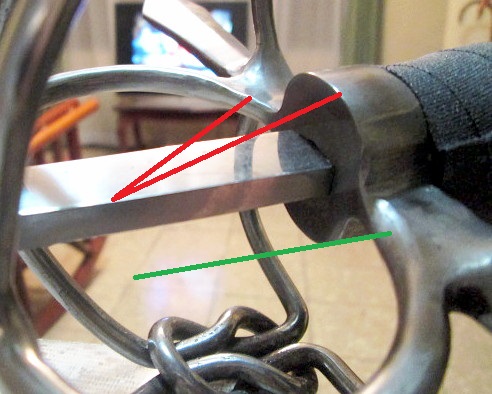 The red lines above show the raw unworked corners. The green line shows work in progress of rounding corners.
The red lines above show the raw unworked corners. The green line shows work in progress of rounding corners.This in addition to giving a little more room, flattened that surface distributing the pressure over a larger area. I can now comfortably grasp the rapier, but more room would be preferable. As for the miserable 1” grip, I increased that to 1¼” by wrapping with friction tape and giving a slight bulge in the middle to better fill my hand. This wrap is a temporary fix using a material that I had on hand. I have ordered rescue tape to finish the job. Rescue tape is unknown to me and if I find it unsatisfactory will order in some tennis racket tape. The friction tape after applying talc powder to the outer surface is working fine but I hope the other tape will be more pleasing to the eye.
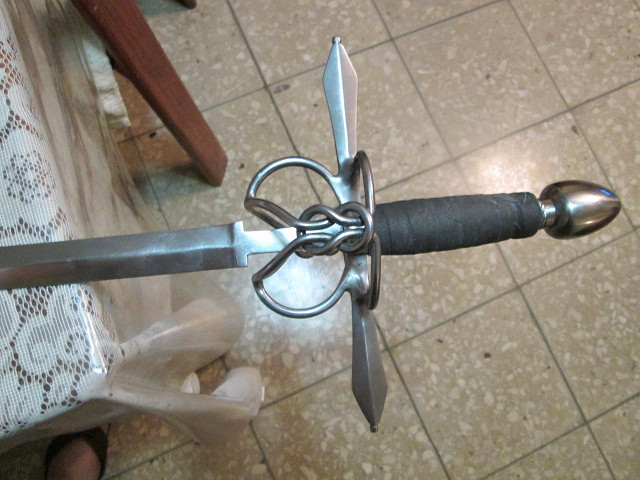 The grip with temporary wrapping
The grip with temporary wrapping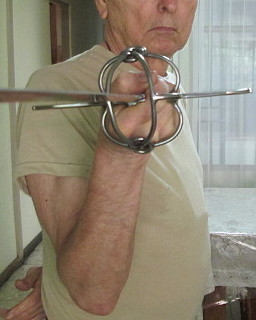 After modification the hand now fits
After modification the hand now fits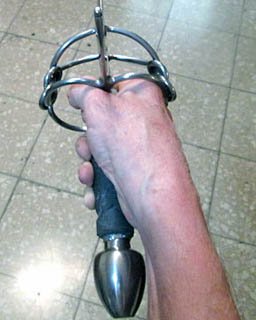 Hand can now enter the quillion block
Hand can now enter the quillion blockGeneral Secondary Opinions
After modifying the grip to the point that I could use the sword I began to grow somewhat intrigued with it and with more time I believe that I will become quite fond of it and a bond is already beginning to grow. It is easy to control and fast. It is outstanding at thrusting. I don’t think cutting will ever be one of its virtues, not to say that it won’t cut. I believe that I am the square peg here. There isn’t that much room to swing a blade that long. On the first cut I halved a juice carton like it was not there. However, I struck the wall in the process. I do get caught up in a clothes line regularly that I will bring down once I get a replacement giving more room. The end result is that I am so afraid of hitting something that it affects my form and I hold back. I will continue further after I get a second line.
The Blade
This was the prime selling point. My blade measures 36 1/8” (after
losing a generous 1/16” from the point). And I thought the advertised
36 5/8” a little short. However, when adding the ricasso’s length the
total is now 38 1/8”. The primary requirement that I was looking for
was a stiff blade. I agree with Beowulf, the blade is stiff. There is
some flex but I would by no means call it whippy but desirable. I had
the forward 19” sharpened. I like my choice as this gives more area for
me to hold on to comfortably while handling the sword other than the
grip. It came paper cutting sharp but with the damaged point and
grinding marks I felt compelled to rework it. It is now razor sharp. I
received two cuts today, one above my knee where I had the blade
resting in my lap. And the other on my thumb when the blade went
through the rag I was using to wipe off oil.
Hilt & Quillion Block
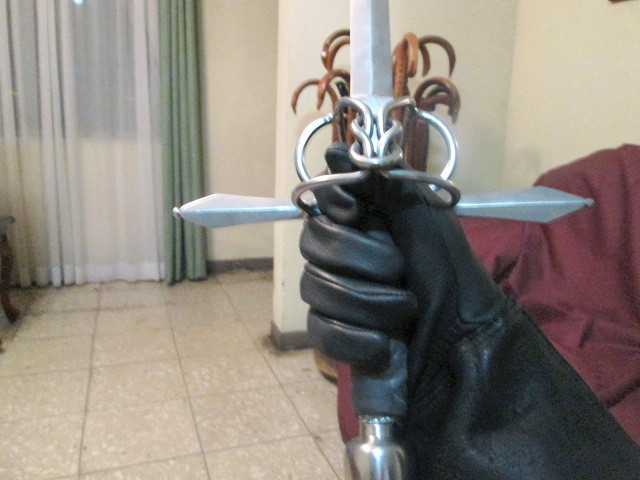
There is nothing to add here that hasn’t already been stated other
than the quillions allow me to know the orientation of the blade with
the round grip and the pommel. That I am glad to say is to my liking.
Most pommels I looked at flared outwards at the distal end. I am not
familiar with rapiers but that seemed to me like that could be
uncomfortable with some moves. The Pilsen’s pommel tapers inward at the
distal end and is comfortable.
I found the scabbard on the whippy side. It is so flexible that it
is possible for it to slap the blade with the rapier is sheathed. There
is no loud audible rattle, only a low level thump, thump that is felt
more than heard. It is made of two pieces of leather with a band over
the join. I don’t know if this is to economize on the leather or for
strength, perhaps both. I would have liked to have a one piece leather
covered scabbard, but then this is a $200 intro. I would also like to
see a stud at the throat to better secure the scabbard in a frog. The
scabbard is a good fit for rapier which is secure in the scabbard when
sheathed. The engraving, for a lack of a better word, is better
executed than I thought it would be.
Conclusion
I like the Pilsen. I can’t say that I would recommend it because of the small quillion block with square corners. If someone is willing to overcome those deficiencies this maybe is for them as it handles well and argumentatively attractive.
I compared it with my back yard katana and I dare say the rapier won. I used a gallon plastic jug, a common target for back yard cutters. However, for a twist I covered it with one rug. The katana made a pin hole size cut in the jug. So small I wasn’t aware of it at first. The blunt trauma was more evident. The filled jug weighed only 8½ lbs so it did not offer much resistance to the strike before falling off the stand. After patching I took the same jug and put three rugs over it. The rapier completely penetrated the all rugs and jug on a thrust. I didn’t have a fourth rug. I believe the rapier with a buckler might be a better weapon for my home than my katana. I have long suspected my katanas with their 29” blade might be long for the house because of the radius of the swing. I had considered a ko katana or a two handed wakizashi.
The rapier doesn’t require as much lateral space nor do I have to be worry about the ceiling. I can hole a target at 9½’ with a thrust with only a simple step forward foot. Some fancy foot work will extend that. It also makes targeting a leg easier.
I hope this double review of the Pilsen Rapier has been helpful. To return to Renaissance Swords from Windlass Pilsen Rapier Review, click here

Buying Swords Online Can Be DANGEROUS!
Find the Best Swords in the:
Popular & Recommended ARTICLES

The ONLY true free online magazine for sword enthusiasts. Delivered once a month on the 1st day of the month, no filler and no BS, just the latest sword news & info delivered straight to your inbox.












